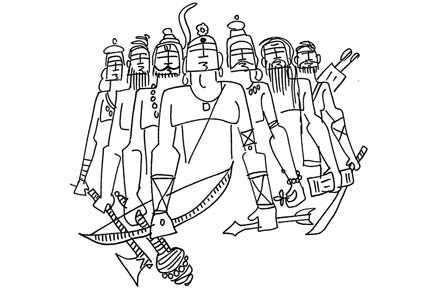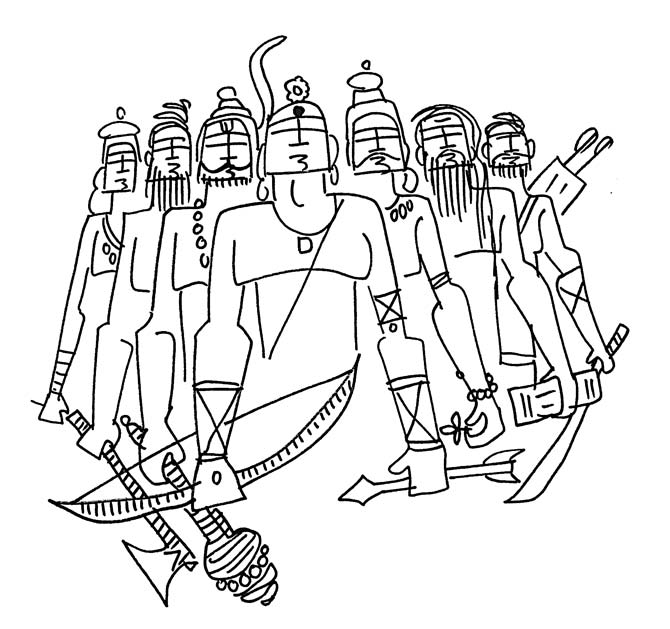In Hindu mythology, whenever an asura asks for immortality, Brahma tells them that they can have whatever they wish except that


Illustration/Devdutt Pattanaik
ADVERTISEMENT
 In Hindu mythology, whenever an asura asks for immortality, Brahma tells them that they can have whatever they wish except that. The clever asura then asks for a boon that will render him immortal for all practical purposes. But, embedded in the boon is a loophole, a vulnerability that the devas take advantage of, to kill him. Thus, we are reminded that no one is immortal in the world.
In Hindu mythology, whenever an asura asks for immortality, Brahma tells them that they can have whatever they wish except that. The clever asura then asks for a boon that will render him immortal for all practical purposes. But, embedded in the boon is a loophole, a vulnerability that the devas take advantage of, to kill him. Thus, we are reminded that no one is immortal in the world.
However, this concept is countered by the concept of 'Chiranjivi' or the immortals of Hindu mythology. These are male characters from various stories in the Ramayana, Mahabharata and Puranas who live forever. Some are cursed.
Others blessed. Some are denied death. Some are burdened with life.
Traditionally, there are seven immortals. They are:
1. Bali, the asura-king, vanquished by Vishnu in his dwarf avatar
2. Parashurama, the priest-warrior avatar of Vishnu
3. Hanuman, the wise and mighty monkey who serves Ram
4. Vibhishana, who is Ravana's brother
5. Vyasa, organiser of Veda and composer of the Mahabharata
6. Kripa, the brother-in-law of Drona, and teacher of the Pandavas
7. Ashwatthama, the son of Drona
The eternal Bali returns to Kerala every year during Onam festival as he embodies prosperity. Hanuman, Vibhishan, Vyasa, and Kripa have been given immortality to remember Ram and Krishna. Parashurama is immortal to defend the earth as he killed all the warriors himself. Ashwatthama is the most famous immortal. He is immortal as punishment for daring to kill an unborn child and for the audacity of releasing, despite not having knowledge to control it, the Brahmastra, a terrible missile that could destroy the world.
Sometimes, the sage Markandeya is added to this list, making it eight immortals. It is he who tells the Ramayana to the Pandavas and informs everyone of how pralaya will eventually destroy the world. It reminds us of the concept of eight immortals found in Taoist mythology. While in Chinese mythology, one of the eight immortals is a woman and another is androgynous or sexually ambiguous, in Hindu mythology, all eight are male.
There are other characters who are immortal in Hindu mythology but who do not make it to the list. For example, Muchukunda, the son of Mandhata, who slept so long in a cave after a war, that when he opened his eyes, his first glance was so fiery that it set aflame the man who had rudely interrupted his sleep. There is Kalyavana, destroyer of Mathura, enemy of Krishna. Or Jambavan, the bear who served in Ram's army and helped in the rescue of Sita. Or Banasura, the father of Usha, who was defeated by Krishna, but blessed by Shiva. And Udal, brother of Alha, whose Rajput saga from medieval times is popular in the Bundelkhand region.
Besides humans, there are immortal plants and animals, like Akshaya-vat, or the banyan tree which will survive pralaya or the great deluge; Kaka Bhusandi, or the immortal crow, who narrates the Ramayana to Narada; Akupara, or the immortal turtle, who holds the earth on his back; and, Sesha, the immortal serpent, who binds the oceans in his coils. For a culture that grappled with impermanence in the world, these characters reveal a deep hidden yearning for permanence and immortality.
The author writes and lectures on the relevance of mythology in modern times. Reach him at devdutt@devdutt.com
 Subscribe today by clicking the link and stay updated with the latest news!" Click here!
Subscribe today by clicking the link and stay updated with the latest news!" Click here!






